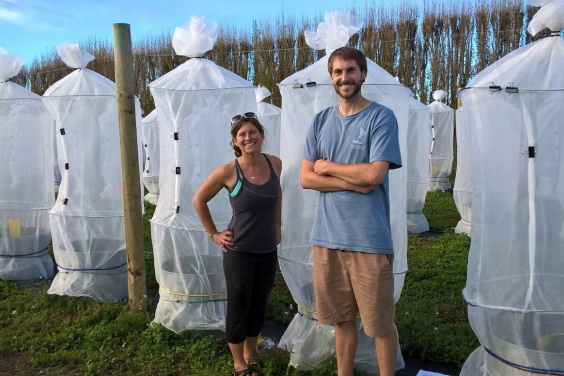15 June 2021
 Invasion ecology has long suggested exotic species can become successful by escaping their natural enemies. A long-running Bio-Protection Research Centre experiment challenges this, showing that exotic plants dominate their communities, despite accumulating and sharing herbivores more than co-occurring native plants.
Invasion ecology has long suggested exotic species can become successful by escaping their natural enemies. A long-running Bio-Protection Research Centre experiment challenges this, showing that exotic plants dominate their communities, despite accumulating and sharing herbivores more than co-occurring native plants.
The Enemy Release Hypothesis predicts that exotic plants become successful because they escape from natural enemies, compared with native species. However, studies testing whether exotic species escape (known as community enemy release) or attract (biotic resistance) natural enemies have produced mixed results.
We set out to test whether plant-herbivore interactions systematically favour exotic plants. We established 160 experimental plant communities, each containing eight plant species selected from a pool of 39 (19 natives, 20 exotics) that co-occur in Aotearoa New Zealand grasslands. We added 20 species of invertebrate herbivores to half the pots, all of which were enclosed in 2.2 m tall mesh cages. The herbivores were a mixture of seven native and 13 exotic species, including New Zealand grass grub (Costelytra giveni), three species of leafroller caterpillar, several exotic aphid species, and the native grasshopper Paprides nitidus. Most of the herbivores were polyphagous, meaning they feed on several hosts.
Setting up this experiment was a massive logistical exercise. We literally applied New Zealand’s ‘no. 8 wire’ approach, using more than 1 km of the eponymous fencing material to support the cages, and 4 km of thread to sew them all together. All of this work required a small army of helpers, including graduate and undergraduate students, support staff, and friends and family.
We surveyed plants for herbivores eight times during the one-year experiment, counting the number of individuals of each species we saw feeding on each plant and calculating their dry biomass. For species that were highly mobile or lived below ground, we extracted DNA from herbivore regurgitate (vomit) and frass (faeces) samples, and used a molecular technique named restriction fragment length polymorphism (RFLP) to identify the host plant.
Not what we expected
The results surprised us: rather than exotic plants suffering less herbivory than their native neighbours, they supported higher native and exotic herbivore diversity and biomass, and were more damaged. We also took the crucial step of measuring how herbivory affected plant performance, finding that exotic plant biomass was 30% lower in mesocosms with herbivores than those without herbivores, while the biomass of native plants was unaffected.
Despite suffering such strong herbivory, exotic plants consistently dominated the biomass of mesocosm communities, potentially because of their indirect interactions with neighbouring plants. Many herbivores that attacked the exotic plants also fed on other species, indicating that exotic plants may be successful because they support polyphagous herbivores that affect neighbouring plants. However, we found no evidence that these indirect interactions affected neighbours’ biomass. Therefore, it is likely that the exotic plants’ faster growth rates simply allowed them to overcome the high levels of herbivory and still dominate the communities.
Our study represents one of the most comprehensive tests of community enemy release and biotic resistance to date. We conclude that polyphagous invertebrate herbivores are unlikely to play significant direct or indirect roles in mediating plant invasions, especially for fast-growing exotic plants. You can read the full paper in Nature Communications.
